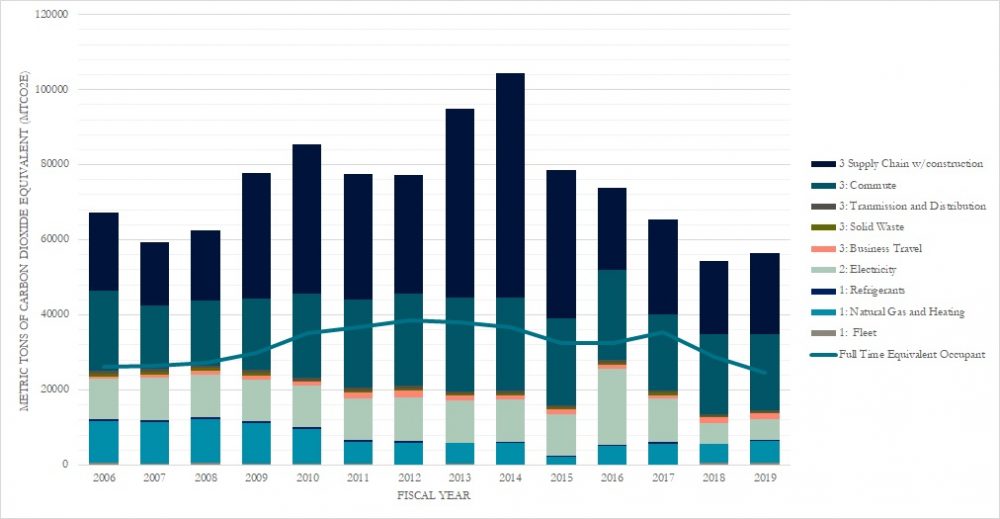GHG Inventory Update 2019
Overview
 The Portland Community College Sustainability Department completes an annual greenhouse gas (GHG) inventory to monitor our institution’s progress toward meeting our GHG reduction targets as outlined in the Climate Action Plan. PCC’s 2013 Climate Action Plan goals are to:
The Portland Community College Sustainability Department completes an annual greenhouse gas (GHG) inventory to monitor our institution’s progress toward meeting our GHG reduction targets as outlined in the Climate Action Plan. PCC’s 2013 Climate Action Plan goals are to:
- Reduce greenhouse gas emissions to 40% below 2006 levels by 2030; and
- Reduce greenhouse gas emissions to 80% below 2006 by 2050
PCC’s greenhouse gas emissions are influenced by student and educational needs, staff commuting behavior, electronics use, operational efficiency, building design, utility choices, and purchasing behavior. We look at our emissions in terms of the amount of direct influence we have and divide them by scope accordingly. Our Scope I and II emissions chiefly consist of emissions from heating and lighting buildings and running electrical equipment and are where PCC has the greatest opportunity to influence change, through green building design and improvements in operations, energy efficiency, and education and outreach.
Our Scope III emissions are more challenging to both measure and influence. They include emissions from commuting to the college by both staff and employees, college purchases of goods and services, and business travel. Both supply chain emissions and commuting emissions have unique challenges in terms of measuring change. While we have undertaken many significant projects to reduce the emissions from our supply chain through greener purchasing, supply chain emissions are chiefly measured by spending and it is difficult to separate green spending from non-green spending at this time. Furthermore, commuting emissions tend to fluctuate with student enrollment and while significant commuters utilize alternative transportation, the sheer number of people commuting to campus each day overshadows this.
Greenhouse Gas Emissions
Operating Buildings and Grounds (Scope I and II Emissions)
Between 2006 and 2019, Portland Community College reduced its Scope 1 and 2 emissions from operating PCC buildings and grounds by nearly 51%, with emissions of 10,736 metric tons of carbon dioxide equivalent (MTCO2E) in 2019, compared to emissions of 21,846 MTCO2E in 2006. Infrastructure investment and energy efficiency campaigns have had significant positive results, although those results continue to battle overall college expansion, leaving our overall emissions reduction behind at nearly 7%.
Building energy consumption associated with greenhouse gas emissions has seen a significant reduction of nearly 28% over PCC’s 2006 baseline, despite an increase of space at the college of over 31%.
Overall, PCC has decreased the total building energy consumption use per square foot by over 45%. PCC’s innovative investment in LEED-certified green buildings, lighting upgrades, and behavior change programs have helped to reduce energy use and climate change impacts.
Travel, Commuting, Purchasing, and Solid Waste (Scope III Emissions)
Overall Scope III emissions make up the largest share of PCC’s emissions at 68.1%. Scope III emissions are roughly at 2006 levels. Scope III emissions are tied to our enrollment levels as they are based on our spending patterns and student commuting patterns.
The largest contributors to scope III are commuting emissions and purchases made by the college. Commuting emissions make up about 38% of the emissions, while emissions from purchases (aka our supply chain) make up 36% of emissions. Business travel is relatively small at around 3, while solid waste makes up less than 1% of emissions. The college has also taken on significant initiatives to help address these sources of emissions. For example, providing options for students to green their commute to school includes providing inter-campus shuttles, offering subsidized bus passes to students, supporting public transportation to our facilities, and using grants to promote active transportation such as bicycling and walking; however, other factors have our community driving more and taking longer routes to the college. We are also working closely with the Purchasing Department and other college buyers to advance sustainable purchasing practices.
The college is working on a wide variety of initiatives to reduce our greenhouse gas footprint. Many of these efforts are outlined in the Climate Action Plan and Sustainability Leadership Council annual work plans. If you would like to learn more or are interested in getting involved, email sustainability@pcc.edu.
